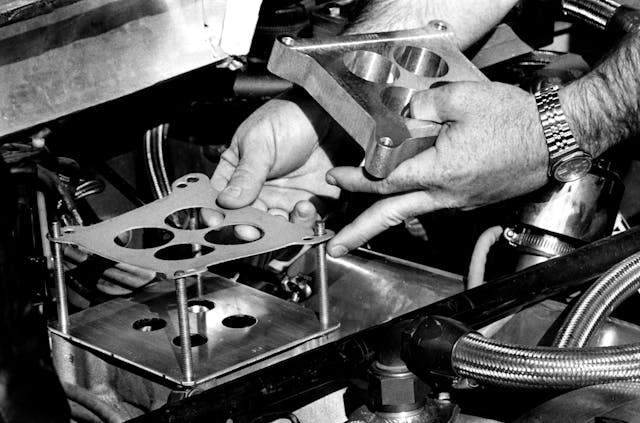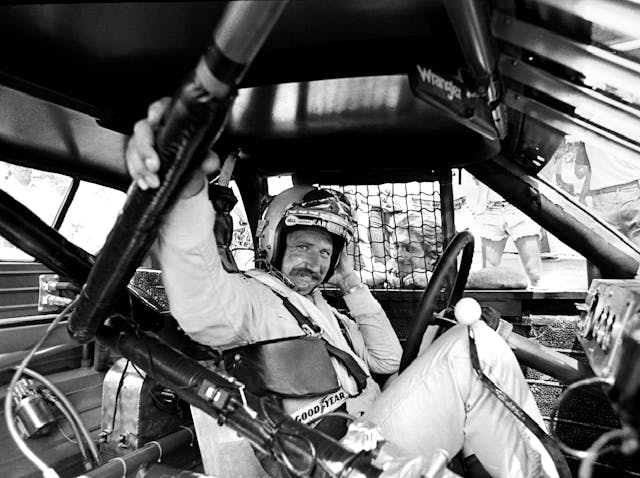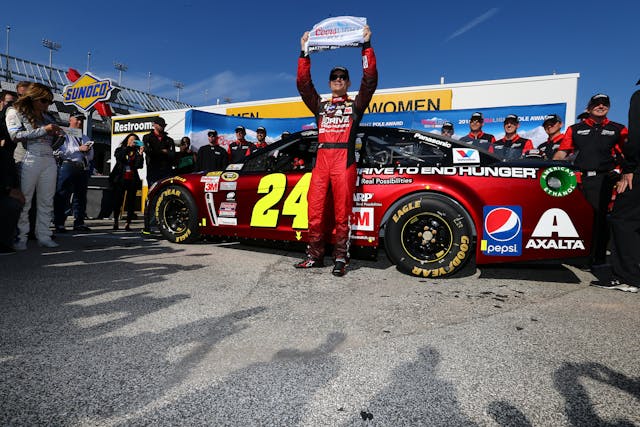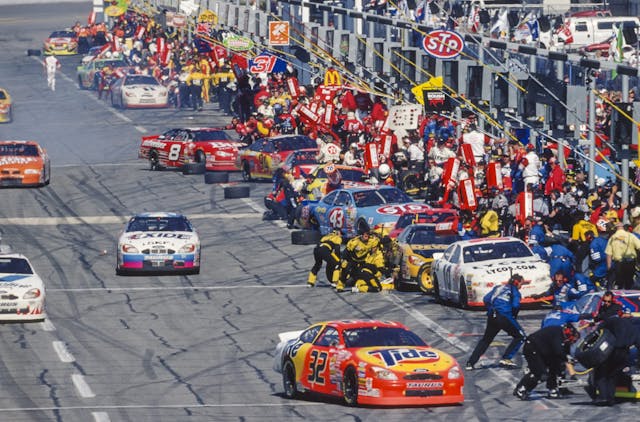13 memorable moments from the Daytona 500
In the beginning, there was Daytona, and it was good. The spiritual home of NASCAR, the Daytona International Speedway was the creation of William Henry Getty France Sr., otherwise known as “Big Bill.” France formed the National Association for Stock Car Auto Racing in 1948, and in 1953, he proposed the building of the first superspeedway, the Daytona International Speedway. The project broke ground on November 25, 1957; the tri-oval track consisted of 2.5 miles, with banking of 31 degrees in the turns and a 180-acre infield. The first race was held on February 22, 1959, and since then, Daytona has been the biggest and brightest star in the NASCAR firmament. Starting with the 1982 race, it has served as the season-opening race of the series.
Daytona has been the backdrop to NASCAR’s greatest triumphs and its greatest tragedies. With the 2021 race set for this Sunday, we take a look back at some of Daytona’s most memorable moments.
Lee Petty wins the first race at Daytona
The inaugural race at Daytona was called the “500-Mile International Sweepstakes” and was won by Lee Petty—but not without controversy.
In the race’s final laps, Petty and his 1959 Oldsmobile Super 88 were locked in a battle with Johnny Beauchamp, in a 1959 Ford Thunderbird, and Joe Weatherly, who was down several laps in a 1959 Chevrolet. Petty and Beauchamp crossed the finish line for a photo finish, with Beauchamp on the inside track, Petty in the middle, and Weatherly on the outside.
Beauchamp was named the unofficial winner, and he took his place in victory lane. However, Petty protested the results: “I had Beauchamp by a good two feet. In my own mind, I know I won.” It took Big Bill three days to determine the winner. Aided by the national newsreel, Petty was officially declared the winner. In a 1999 interview regarding the controversial finish, Lee Petty professed his belief that Big Bill knew that he had won but had named Beauchamp the winner to stir up a controversy. Said Petty: “France would have done anything to generate publicity for his racetracks.” Petty would go on to be the patriarch of one of NASCAR’s racing dynasties.
The man who would be king
In 1964, Chrysler debuted its brand-new 426-cubic-inch Hemi V-8. Richard Petty, driving a Plymouth with a Hemi under the hood and the number 43 on its roof and doors, qualified second. NASCAR, realizing how advanced the Hemi was versus the competition, instructed the teams running Hemis to hold back during practice and qualifying.
Petty had built his reputation as a skilled driver on short tracks, but in this race, he displayed his abilities on the superspeedway and led for 184 of the 200 laps. It’s a Daytona 500 record that still stands today. The race lasted 3 hours and 14 minutes, including three caution flags that slowed the race for 19 laps. Petty dominated the race and took the checkered flag one lap and nine seconds ahead of Jimmy Pardue; Chrysler teams took four of the top five spots. The win would be Petty’s first of seven at the Daytona 500, a record that remains unbroken.
Petty vs. Pearson
In the bicentennial year of 1976, David Pearson and Richard Petty were the indisputably the best drivers in NASCAR. As such, the two found themselves in a hard-fought duel for the win in the race’s final moments.
Two laps ahead of the field, the two battled nose to tail. On the last lap, Pearson passed Petty on the backstretch, and Petty tried to pass Pearson in turn 3. Petty didn’t clear Pearson’s car completely and made contact, sending both cars first into the wall and then spinning into the infield grass, mere yards from the finish line. Petty’s car stalled and would not fire back up. Pearson managed to restart his car and crossed the finish line to score his only Daytona 500 victory. Petty, with the help of a push-start from his crew, crossed the line for second. Many fans consider this finish to be the greatest in the history of NASCAR.
Allison and Yarborough duke it out
The finish of the 1979’s race is right up there with that of 1976. The race was televised live from beginning to end, a rare occurrence at the time, and the first for a 500-mile race in the U.S. On the final lap, race leaders Cale Yarborough and Donnie Allison collided with each other on the backstretch, sending both drivers into the infield. The wreck gave Richard Petty his sixth Daytona 500 win.
As Petty made his way to Victory Lane for the celebration, a fight broke out between Yarborough, Donnie Allison, and his brother, Bobby, at the site of the wreck. Both events were caught by television cameras and broadcast live to a captive audience in the Midwest and East Coast, where a huge snowstorm had left people housebound and with only three TV channels to watch.
Bobby Allison had completed the race in eleventh place and was circling around to see if his brother needed a lift back to the garage. Stopped at the scene of the wreck, Yarborough charged over to Bobby and accused him of causing the wreck. Bobby took umbrage with the accusation, said a few words, and then Yarborough smashed Bobby in the face with his helmet. Bobby pulled himself out of the car and, as he would put it later, “Cale started beating my fists with his nose.” Safety workers eventually pulled the two apart, but not easily, as a national television audience looked on in shock.
The race brought NASCAR national publicity. Motorsports announcer Dick Berggren said: “Nobody knew it then, but that was the race that got everything going. It was the first ‘water cooler’ race, the first time people had stood around water coolers on Monday and talked about seeing a race on TV the day before. It took a while—years, maybe—to realize how important it was.” As a result, many consider the 1979 Daytona 500 to be the most important race in stock car history.
Restrictor plates end an era

After Bobby Allison’s Buick launched skyward and nearly landed in the grandstands at Talladega Superspeedway in May 1987, NASCAR began efforts to reduce the speed of its cars. First came smaller carburetors, followed by restrictor plates that reduced the engines’ air intake. The 1988 Daytona was the end of the era of unlimited speeds.
Bobby Allison was 50 years old in 1988 and was approaching the end of his career. Both he and son Davey had qualified for the race, but few expected the elder Allison to be a contender once the green flag dropped. However, he was able to qualify in third and led for a total of 70 laps over the course of the race, including the last 18. He took the checkered flag, with Davey in second. It was his third Daytona and his final NASCAR win.
Four months later, Bobby suffered life-threatening injuries in a first-lap wreck at Pocono Raceway. After months of rehabilitation, his injuries were still so severe that he never regained his memory. To this day, at age 83, he has no recollection of the 1988 Daytona 500.
The Intimidator’s losing streak at Daytona
Dale Earnhardt Sr., seemed to have the 1990 Daytona 500 well in-hand, having dominated the race by leading 155 of the 200 laps. With one lap to go, he drove over a piece of metal from the blown engine of Rick Wilson’s car and shredded his car’s right-rear tire. As he exited turn 3, Earnhardt’s iconic No. 3 black Chevrolet suddenly slowed and swerved toward the outside wall. He coasted down the track, and Derrike Cope drove by Earnhardt to his first-ever victory. Earnhardt’s crew hung the shredded tire on the wall of the race shop and used the loss to motivate them to win the 1990 Winston Cup championship. It is considered to be one of the biggest upsets in NASCAR history and was the beginning of nearly a decade of bad luck in the 500 for the Intimidator.
The Intimidator takes the checkered flag
After 19 years of competing at Daytona, Dale Earnhardt Sr., had successfully competed in practically every variation of races hosted there: He won a pair of 400-milers, seven Nationwide Series races, and more. Regardless, a victory at the Daytona 500 continued to elude him—until 1998.
This time, there would be no flat tire, no ill-timed caution or unplanned pit stop. Earnhardt was leading with two laps left when Lake Speed and John Andretti collided, causing the race to end under yellow. After his win, an overjoyed Earnhardt motored slowly down pit road, where members of the other race teams had lined up to give him handshakes and high-fives. The victory was widely celebrated, even by people who weren’t his fans, and was called “the most anticipated moment in racing.”
Black Sunday

If Buddy Holly’s death was the day the music died, then the death of Dale Earnhardt Sr., is when the old era of NASCAR racing died.
The race on Sunday, February 18, 2001, had started auspiciously enough, with Michael Waltrip on the pole and Dale Earnhardt Jr., in second, both racing for Dale Earnhardt, Inc., Sr.’s racing team. A huge wreck on lap 173 took out 18 cars in epic fashion and the race was red-flagged for cleanup. Only a few drivers, including the Earnhardts, Bill Elliott, Ron Hornaday Jr., and Ken Schrader, were able to avoid the crash with intact cars.
With two laps left, Dale Sr. and Dale Jr. were right behind Waltrip, with Jr. in second place ahead of his father. Heading into turn 3, Sr., holding third, ran in the middle lane of the pack. Just as the field headed into turn 4, Sterling Marlin’s car made contact with the left rear of Earnhardt Sr.’s car, causing the black No. 3 to slide off the track’s steep banking onto the flat apron.
Attempting to correct, Earnhardt Sr. turned up the track toward the outside retaining wall. Although for a moment it appeared as if he would avoid hitting the retaining wall, Earnhardt drove right into the path of Ken Schrader’s car. Schrader plowed into Earnhardt behind the passenger door, causing the car to snap and rapidly changing its angle toward the wall. As Schrader came into contact, Earnhardt hit the wall nose-first at an estimated speed of 155–160 mph. Both cars slid down the steep banking off the track and into the infield grass.
During this two-car wreck, drivers were permitted to race to the finish under the green flag. Waltrip (after 462 races without a win) took his first Winston Cup victory, with his teammate Earnhardt Jr. in second. The yellow and checkered flags came out simultaneously as Waltrip crossed the line, locking the rest of the field in their positions. After crossing the finish line, Earnhardt Jr. stopped at the site of his father’s wreck at Turn 3. Earnhardt Sr. was pulled from his car and transported to the Halifax Medical Center, where he was pronounced dead.
The death of Dale Earnhardt Sr. caused a revolution in racing safety, and so far, no other driver has lost their life in a Sprint Cup race car.
Jr. follows Sr.
Before the start of the race, several cars had to move to the rear of the field due to various issues. As a result, Dale Earnhardt Jr. moved into the first spot and led the opening laps. Several crashes over the course of the race eliminated a number of drivers; the largest crash on lap 71 took out 12 cars, including defending Daytona 500 winner Michael Waltrip. The race restarted on lap 81, and from then on it was a battle between Tony Stewart and Dale Jr.
Combined, the two led for 101 of the remaining 120 laps. Dale Jr. passed Stewart on lap 181 in turn 3 without drafting help and managed to fend him off in the remaining laps to win his first Daytona 500. Jr. won the race exactly three years after his father’s fatal crash on the last lap of the 2001 race and six years after Sr.’s celebrated win at Daytona.
Danica at Daytona

At 2013 Daytona 500, rookie Danica Patrick didn’t just become the first woman to race at Daytona; she also became the first woman to win the pole in a NASCAR Cup Series race. She ran in the top 10 for the entire race and finished eighth, becoming the first woman to finish in the top ten at the Daytona 500.
Gordon goes out

Jeff Gordon won the pole for his 23rd and final career start at the 2015 Daytona 500. Gordon led a race-high 87 laps and ran up front for most of the event. He was caught in the backstretch multi-car wreck on the final lap of the race, however, and finished 33rd.
Closest finish in 500 history
The 2016 Daytona 500 was action-packed, with six caution-flag periods for 31 laps and 20 lead changes between 15 different drivers. After the final caution, the race restarted with 12 laps to go. Matt Kenseth was comfortably in the lead. When the white flag dropped, Kevin Harvick drafted up the outside, overtaking Carl Edwards. Denny Hamlin saw Harvick advancing and took the outside line to block his advance. Hamlin was bumped by Harvick on the back straight and drafted all the way to the front, passing Kyle Busch and Martin Truex and drawing alongside his teammate, Kenseth. Kenseth came down on Hamlin, got loose, and fell back to finish 14th. Hamlin and Truex raced to the finish line and Hamlin prevailed by 0.01 second, the closest margin in Daytona 500 history.
The black No. 3 Chevy returns
The 60th running of the Daytona 500 in 2018 was another crash-filled event, with eight cautions and an accident toward the end that eliminated 12 cars. The race restarted on lap 205 for a two-lap NASCAR overtime period. Aric Almirola was leading at the white flag, but a mistimed block forced Austin Dillon, in the black No. 3 Chevy fielded by Richard Childress Racing, to drive into Almirola’s right-rear corner and put him into the wall. Dillon drove on to score his second career victory. In addition, it was Dillon’s first Daytona 500 win and came 20 years after Dale Earnhardt won the 1998 Daytona 500 in the same seat.
Fun fact: This was the first Daytona 500 race since 1982 in which none of the cars were sponsored by beer companies.


